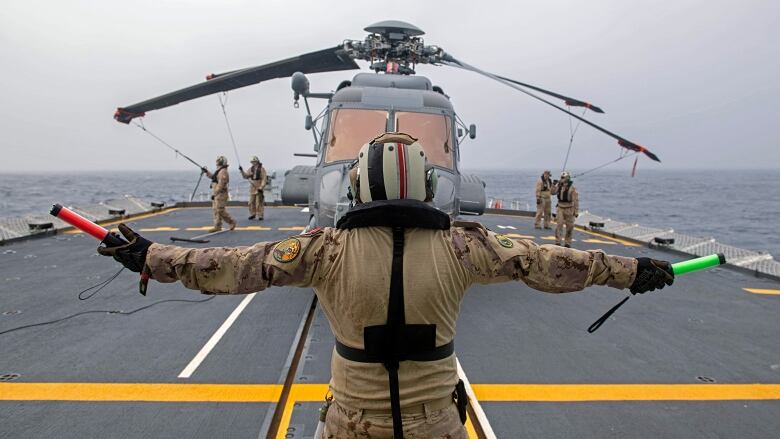Cracks in tails of RCAF Cyclone helicopters raise 'serious concerns,' says expert
'We need to get it right. And so far, it's all going wrong': UBC defence policy analyst

Cracks in the tails of 19 Royal Canadian Air Force Cyclone helicopters are a cause for concern, says an expert.
Michael Byers, a professor and defence policy analystat the University of British Columbia in Vancouver, said thecracks could be indicative of much larger problems with the aircraft.
"Each of these helicopters costs more than $150 million, and the oldest helicopter in the fleet is only five years old," he said on Sunday. "So the fact that there is this problem does raise some very serious concerns as to the quality of the helicopters, the safety of the helicopters."
Only two of Canada's 23 Sikorsky CH-148 Cyclone helicopters are currently fit to fly. The rest of the multibillion-dollar fleet is in need of repair.
On Nov.26, cracks were found in the tail of one of the helicopters at 12 Wing Shearwater in Dartmouth, N.S.Because of this, the rest of the fleet was examinedand most of the helicopters were found to be compromised.
On Saturday, the Department of National Defence (DND) said just four of the Cyclones were affected, but after further questions from CBC News, it was revealed there areactually 19 with cracks. Two helicopters have been out of service due to other matters.
"I'm concerned about the limited news that we have so far," Byers said. "This appears to be a fleet wide problem.... That's obviously an issue in terms of Canada's capabilities. These are the helicopters that go on our frigates and are an essential part of our maritime ability."
Ken Hansen, an independent defence and security analyst and former navy commander, said the cracks were likely caused by the significant power that is used when the Cycloneslandand takeoff.
"The engines that Canada had put into that aircraft were 25 per cent more powerful than the engines that were in the design aircraft, so that's even more power and more force," Hansen told CBC Radio's Information Morning Halifax on Monday.
"Evidently, there's a problem with the structural strength of the aircraft to withstand that force."
In the early 2000s, the CH-148 Cyclone model was chosen to replace the RCAF's five-decade-old CH-124 Sea Kings. Considered a "developmental" helicopter, Canada has the only Cyclones in the world.

The procurement of the Cyclones has been heavily criticized, with former Conservative defence minister Peter MacKay calling the Cyclone program the "worst procurement in the history of Canada."
The original 2004 budget for the Cyclone's procurement was $3.2 billion, but the number grew to $5.7 billion by 2014.
According to the DND, "the cost for major in-service support until 2038 is $5.8 billion."
Canada is still waiting for five Cyclones to be delivered.
"We're spending upwards of $5 billion on this particular small fleet of helicopters, so we need to get it right. And so far, it's all going wrong," Byers said.
'A bunch of lemons?'
Byers said since the Cyclones are new, they should not be having such significant and widespread problems.
"Have we bought a bunch of lemons? Is this a flawed aircraft that will require billions and billions of dollars of additional taxpayer money to keep safe and to keep operational?"
Byers said it'sa good sign thattheaircraft have been grounded, and the worst-case scenario would be if the air force tried to "muddle through" to avoid further criticism ofthe Cyclones.

"The Canadian military needs to get to the bottom of this, it needs to fix the problemand it needs to be fully transparent throughout that process because these are the lives of young men and young women that are put at risk every time these aircraft fly," he said.
Hansen, the former navy commander, was part of the committee that recommended buying the aircraft. He said he stands by the recommendation.
"This aircraft is light years ahead of the old Sea King this aircraft will go on to have a very successful career," Hansen said.
"I have absolutely no doubt because it represents such a quantum leap in capability. This will get sorted out and they'll get back to sea."
Fraught history
This isn't the first time there have been concerns about the tail section of the helicopter.
In 2017, the Canadian Forces grounded its Cyclones after Sikorsky issued a worldwide notice for safety checks to be conducted.
Operators were told to immediately check the tail rotor section of the S-92 aircraft. Cyclones are a militarized variation of that aircraft.
In 2009, anS-92 helicopter crashed off the coast of Newfoundland due to an oil pressure issue, killing 17.
Then in 2020, a Cyclone crashed in the waters off Greece because of a glitch with the autopilot function, killing sixmembers of the Canadian military.
Impact on operations
Seventeen of the Cyclone aircraft are based at Shearwater and six are in Patricia Bay,B.C.
Some of the fleet was supposed to take part in Operation LENTUS, to provide relief after the mass flooding in British Columbia,but it was impossible due to the cracks. Older military aircraft, search-and-rescue helicoptersand non-military aircraft were used instead.
"12 Wing Shearwater, which encompasses the entire fleet, is prioritizing the order of repair to maximize return to serviceability for each aircraft," a DND spokesperson said in a statement to CBCNews.
The department says it hopes to have some of the helicoptersback in the air within the next few days.
MORE TOP STORIES
With files from CBC Radio's Information Morning Halifax












_(720p).jpg)


 OFFICIAL HD MUSIC VIDEO.jpg)
.jpg)



























































































